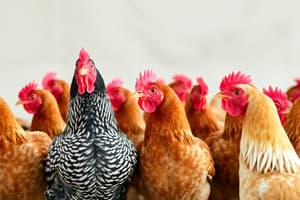Podcast
Questions and Answers
Nối các bộ phận cơ thể của gà với mô tả tương ứng:
Nối các bộ phận cơ thể của gà với mô tả tương ứng:
Mỏ = Được sử dụng để gặm Lỗ miệng nhỏ = Có một miệng nhỏ Màng da dưới mỏ = Phần da thịt phía dưới mỏ Tim 4 buồng = Bộ phận trong tim có 4 buồng
Nối các thông tin về gà với mô tả tương ứng:
Nối các thông tin về gà với mô tả tương ứng:
Gà giống Leghorn = Một trong những giống gà phổ biến Gà mái Orpington = Một trong các giống gà nổi tiếng Gà mẹ Red Junglefowl = Loài gà mẹ của gà nuôi Gà Rhode Island Red = Một trong các giống gà nổi tiếng
Nối các hành vi và cách giao tiếp của gà với mô tả tương ứng:
Nối các hành vi và cách giao tiếp của gà với mô tả tương ứng:
Thực hiện tắm bụi = Cuộc vật lý để loại bỏ ký sinh trùng Thành lập thứ bậc = Xác định thứ hạng xã hội trong đàn Giao tiếp qua cử động cơ thể = Giao tiếp bằng cách di chuyển cơ thể Tiếp xúc qua tiếng kêu = Giao tiếp bằng âm thanh
Ghép đôi loại thức ăn cần thiết cho gà:
Ghép đôi loại thức ăn cần thiết cho gà:
Ghép đôi công dụng của phân gà:
Ghép đôi công dụng của phân gà:
Ghép đôi đặc điểm của gà:
Ghép đôi đặc điểm của gà:
Ghép đôi môi trường mà gà có thể sống:
Ghép đôi môi trường mà gà có thể sống:
Flashcards are hidden until you start studying
Study Notes
Chickens: Feathered Facts and Farmyard Friends
Chickens are a familiar sight in backyards, farms, and supermarkets, but their intriguing nature and diverse roles extend well beyond their egg-laying and meat-producing capacities. Let's delve into the world of these feathered friends, detailing their history, anatomy, behavior, and importance in our lives.
Origins and Species
Chickens are domesticated descendants of the Red Junglefowl (Gallus gallus) found in Southeast Asia. This ancestor species still exists but has been selectively bred to produce a wide variety of chicken breeds, each with unique characteristics. Some of the most popular breeds include the Leghorn, Rhode Island Red, Plymouth Rock, and the Orpington.
Chicken Anatomy
Chickens are warm-blooded animals with a bony, feathered body. They possess a beak, used for pecking, a small mouth, and a protruding, fleshy wattle under their beak. Chickens have a four-chambered heart, two lungs, and a crop, which is a temporary storage area for food and water.
Behaviors and Communication
Chickens are social creatures that communicate with one another through vocalizations, body postures, and other physical cues. They are capable of forming pecking orders, which establish the social hierarchy within their flock. Chickens are also known to perform dust baths, where they roll around in the dirt to remove parasites and maintain clean feathers.
Thriving in Various Environments
Chickens are adaptable creatures that can thrive in a variety of environments, from large farms to urban backyards. They require a specific diet consisting of a balanced mixture of grains, vegetables, and minerals to ensure proper growth and health. Chickens also need a dry, clean place to sleep and a safe place to lay their eggs.
Chickens in Our Lives
Chickens are a valuable resource to human societies. They provide eggs and meat as a source of nutrition, and their manure is used as a natural fertilizer to improve soil health and crop production.
Chickens are also kept for their ability to control pests, as they consume insects and worms. They have even been known to clear land of weeds and help control rodent populations. Additionally, chickens are often used in educational settings, such as in farms, where children learn about animal care, sustainability, and the food production process.
Conclusion
Chickens have been an integral part of human societies for centuries. They are fascinating creatures that have been carefully selected and bred for their unique characteristics. Chickens are adaptable, social, and valuable resources that continue to contribute to our lives in numerous ways, from providing food to teaching us about animal care and the environment.
Studying That Suits You
Use AI to generate personalized quizzes and flashcards to suit your learning preferences.




